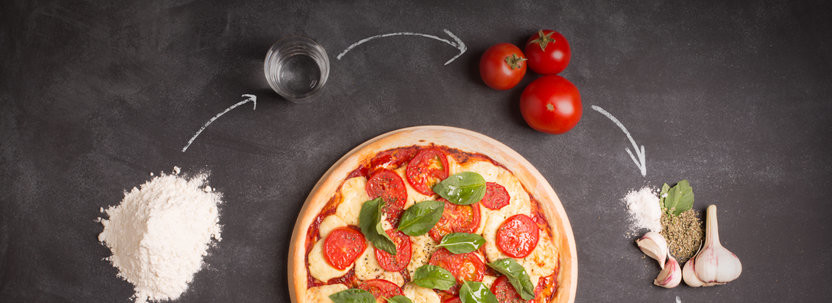
Pizza crust production is a hot space to be in the food production and baking industry. Large scale pizza production usually includes manufacturing frozen pizza dough, frozen par-baked pizza shells, and frozen fully topped par-baked pizza shells. More and more the production of shells and topped pizza shells is done on automated lines. Here are a few production tips for whatever type of pizza you’re baking.
How to make a thin crust pizza
It is essential to form a firm dough after mixing for thin crust pizza. The dough should not absorb topping liquid which causes it to become soggy. The recipe should contain strong flour with 13-14% protein. Often gluten is added to increase the protein concentration of the flour. Lower water absorption rates (55-60%) and higher shortening levels should be used. It helps prevent sticking during the stamping process. A significant amount of shortening should be used to maintain the texture of the finished crusts. Sometimes thin crust pizza is leavened with both yeast as well as chemical leavening.
How to make a thick pizza crust
A thick crust pizza calls for a more bread-like texture. Comparatively, the recipe uses a flour with a lower protein concentration (12-14%). Contrary to a thin crust base, you want to achieve a higher water absorption rate (60-70%) and a higher sugar level to support the yeast fermentation. In that kind of recipe, the shortening levels are usually lower.
What are some ingredient solutions that have great functionalities for pizza making?
It can be challenging to make quality pizza crusts. With the use of specific functional baking, formulations can be optimize to yield a dough with superb handling and baking characteristics. For example,
- Instant dry yeast that naturally contains small amounts of glutathione, a dough relaxation compound, can be used to solve some of your dough problems and help give you the perfect pizza.
- More concentrated chemical reducing agents, such as cysteine or sodium metabisulfite can be used to minimize shrinkage and snapback problems. But if you are looking for a clean-label reducing solution, glutathione-rich inactive yeast will deliver on dough extensibility. It will also allow you to sheet or press the dough piece to the desired diameter and avoid shrinkage and snapback.
- Pizza doughs going through the stress of automated process line tend to be weaker and unable to retain CO2 gas properly. This creates pizza crust with inconsistent thickness and texture. Dough strengtheners such as DATEM and SSL can give you more volume and a finished product that meets target thickness, but these oxidizing agents are not clean label. That’s why many bakers are now converting to baking enzyme blends that can provide the same benefits and keep a clean label.
- Thick pizza crust manufacturers are often looking for ways to improve crumb softness and prevent the crust from drying out during. They often turn to mono- and diglycerides for a quick fix, although baking enzyme blends can provide the same benefits and keep a clean label.
Critical steps in the pizza dough process
Sheeting
Doughs prepared for thick pizza crust normally go through a sheeting step. The mixed dough is sheeted by going through a series of progressive rollers. Then the pizza shells are die-cut to the desired shape. To maintain a consistent thickness and texture without tearing, the dough must have good handling properties. The dough should not be shrinking after cutting or during the baking cycle. Otherwise, consumers will believe are being shortchanged.
Stamping
Wholesale bakeries normally use a stamping process to flatten the dough to make a thin pizza. In this process, the mixed dough is divided into the desired weight. The divided dough is then let to relax during an intermediate proofing. These dough balls are conveyed to a hot press and stamped to the desired thickness to achieve the set target diameter. Maximum extensibility without being sticky is critical to achieve the desired size and to prevent shrinkage. This process is rather more labor-intensive compared to the sheeting process.

